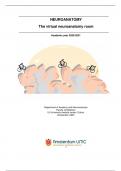Overig
Neurosciences (AB_1200) - Neuroanatomy epracticum answers
- Instelling
- Vrije Universiteit Amsterdam (VU)
The filled-with-answers document of the Neuroanatomy practical 'The virtual neuroanatomy room'. Can also be used as learning material for the exam.
[Meer zien]




